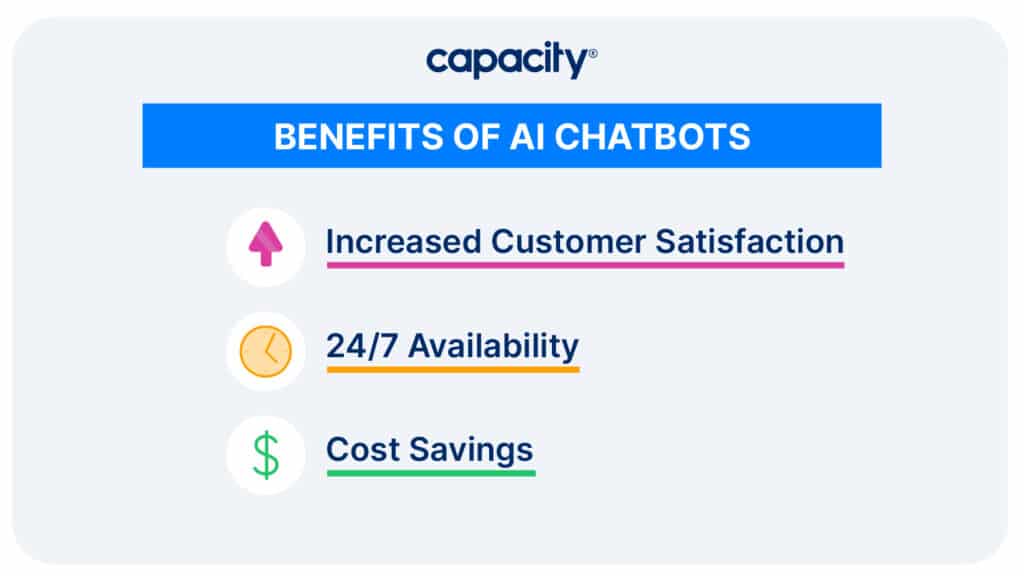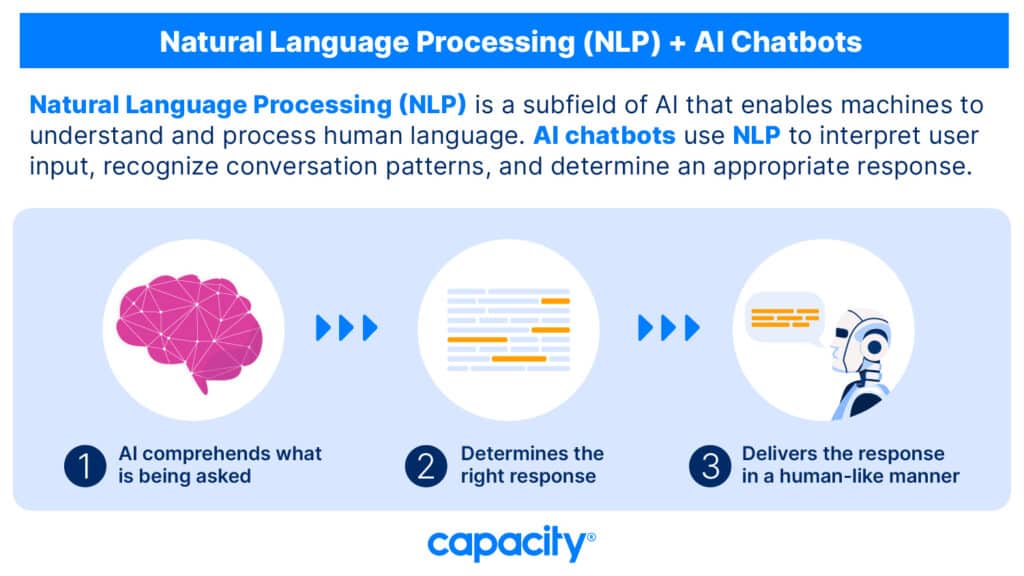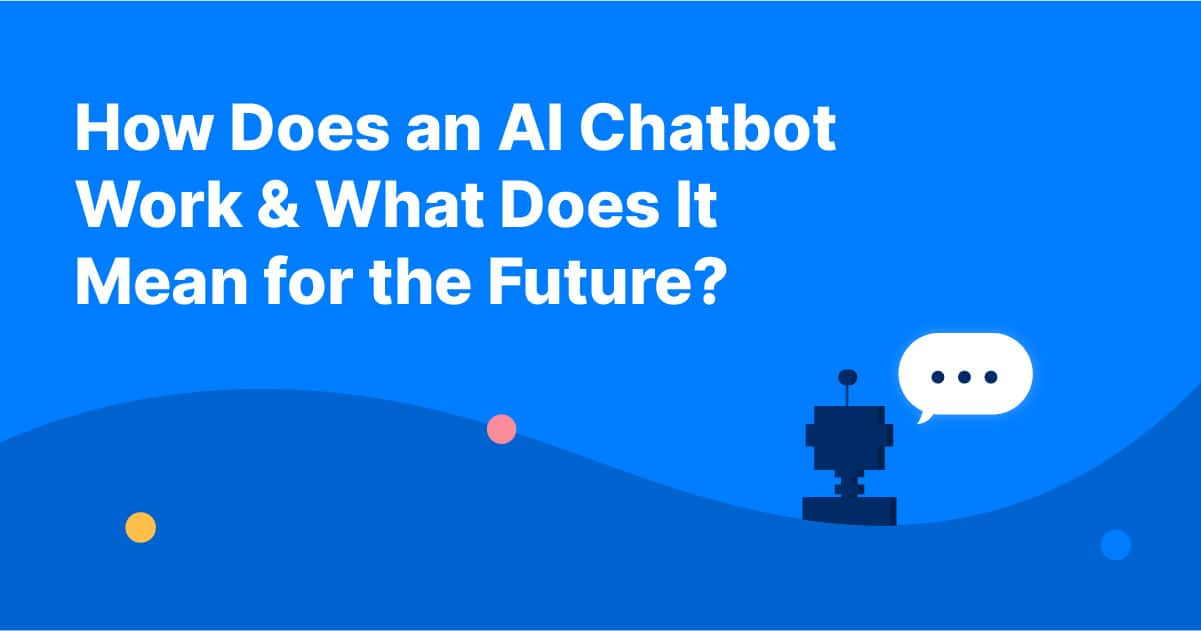In the not-so-distant past, chatbots were merely a novelty for customer service. But these bots have become incredibly sophisticated- and undeniably mainstream with recent advancements in AI, machine learning, and NLP technologies. According to a recent report, the chatbot market is projected for rapid growth in the next decade. Already valued at USD $4.7 billion in 2022, this technology sector is predicted to grow 23.3% in the next four years to $15.5 billion – making it one of the most profitable industries within today’s economy.
E-commerce isn’t the only sector embracing AI chatbots: Entire industries are seeing the light, including healthcare, banking, hospitality, and more. AI chatbots are being used for everything from restaurant reservations to virtual medical consultations, and the applications of this technology are continuing to expand rapidly.
At the core of a modern-day AI chatbot is NLP (Natural Language Processing) technology, which enables the machine to understand and interpret human language. The chatbot can provide a personalized and real-time conversation with humans by analyzing input data, running it through an algorithm, and responding with a natural-sounding reply. That’s great, but what does it all mean?

Get Started with AI
Capacity’s customized AI Assessments can help:
- Identify opportunities for using AI
- Prioritize use cases that fit your goals
- Build an action plan for implementation
The race to embrace AI chatbots.
With the emergence of AI, companies that ignore this trend do so at their peril. Chatbots are a great way to gain an understanding and appreciation for just how powerful they can be. If you find all things related to AI somewhat daunting, then think of chatbots as your safe entry point into the world of new possibilities.
Chatbots: AI’s most valuable asset for organizations
It’s important to understand how an AI chatbot works and why it is impacting businesses. AI chatbots provide instant replies, so customers feel they are heard and their time is valued. By capitalizing on consumers’ preference for online chatting over sitting on hold, wait times can be dramatically reduced. At the same time, conversion rates soar – particularly among consumers who need instant support or access to their personal information. For example, an AI chatbot could say something like: “I see you’re trying to access your information; let me help you get there.

Through a series of guided conversations, AI chatbots give consumers the information they need without the hassle of waiting for an email or customer service representative. Conversely, AI chatbots can take over mundane tasks and save employees time.
Moreover, AI chatbots can assist e-commerce businesses in making product suggestions tailored to a user’s browsing history, prior purchases, and demographic information. This helps companies provide 24/7 customer service at a lower cost because these bots don’t need days off or vacations. On top of that, they can also handle tedious tasks such as finding out where the package is located, which saves valuable time for live agents dealing with more exciting requests – thus improving employee engagement.
Furthermore, an excellent AI chatbot combined with actual people can aid any business in coping with unexpected spikes in demand (like during holiday shopping) or sudden drops in the availability of customer service representatives, like when employees are sick or when there is an extraordinary rate of customer service inquiries (anyone remember attempting to get help from customer support at the apex of the pandemic?).
Chatbots can significantly benefit businesses and customers alike, as they dramatically reduce customer service wait times and are essential components of any business continuity plan.
How AI chatbots work
A chatbot is an automated conversational AI that pretends to be human and carries out programmed tasks based on specific triggers, responding through a web or mobile app. Much like virtual assistants, these bots provide support for users in the same way as one would talk with another person. With its unique ability to simulate a conversation between two people, you can harness this technology’s power to add convenience and efficiency.
The most fundamental type of chatbot is a question-answer bot — an AI that uses predetermined rules and tree paths to provide predefined solutions for specific inquiries. This form of chatbot does not use sophisticated artificial intelligence but instead has access to a knowledge base and utilizes pattern recognition.
But the chatbot can become even more convincing and life-like when you incorporate artificial intelligence programming. Advanced AI-based bots utilize a database of information, deep learning, machine learning, and NLP to recognize patterns in conversation. This allows them to respond realistically and engage users as humans do!

Chatbot programs are designed to delight customers by utilizing an AI-driven algorithm that successfully scans customer support documentation and past conversations for text patterns similar to the original inquiry. This allows it to deliver the most appropriate answer quickly and accurately.
Apple’s Siri, Amazon’s Alexa, and Google Assistant are prime examples of revolutionary chatbots powered by advanced generative algorithms. Using specific rules and prior interactions, bots can provide insightful replies to any query thrown at them – making their responses both accurate and creative.

Get Started with AI
Capacity’s customized AI Assessments can help:
- Identify opportunities for using AI
- Prioritize use cases that fit your goals
- Build an action plan for implementation
AI chatbot algorithms: machine learning, deep learning, and natural language processing
To fully comprehend natural language, many sophisticated models have been developed, such as Pattern matching, Naïve Bayes, Sequence to Sequence (seq2seq) model, Recurrent neural networks (RNN), Long Short Term Memory (LSTM), and NLP. All of these approaches enable us to gain insight into the nuances of human communication.
Leveraging machine learning, computers can analyze and interpret data to discern patterns autonomously without human intervention. This allows them to make informed decisions based on their gathered information.
AI chatbots need humans.
Humans, believe it or not, are at the heart of a good chatbot. The more the program runs, the more humans feed the bot, and the greater understanding it gains from its database – thus becoming increasingly intelligent. For instance, a machine-learning chatbot can assist customers in finding products or services on a website quickly, provide immediate answers to inquiries, or even send out personalized updates and notifications.
Deep learning chatbots are crafted with unique machine learning algorithms – one of the most advanced forms of automation. These bots require little human input and can imitate conversations that appear as if they were between two humans! By incorporating multiple layers of artificial neural networks in their design, these deep-learning chatbots use structured data from authentic dialogue to make informed decisions.
NLP + AI chatbots
An NLP layer is required for artificial intelligence chatbots to emulate natural conversation. Through predictive analytics, sentiment analysis, and text classifications, this layer interprets input the same way as people do.
By combining predictive analytics and sentiment analysis, we can revolutionize how we interpret the future. Predictive analytics combines big data, modeling, artificial intelligence, and machine learning to create an accurate picture of what may be coming soon.
Chatbot algorithms can break down user queries into entities and intents, allowing them to detect specified keywords and take appropriate actions. For example, when a customer inputs “I want to order a bag.” or “Do you sell bags? I want to buy one.”, the bot will understand both statements in the same way – providing customers with options for purchasing bags on your website.

Thanks to the powerful technology seamlessly integrated into chatbots, customers will feel like they’re chatting with an actual human being – even though their conversation partner is a machine. It’s such a natural experience that it can be challenging to differentiate it from having a genuine discussion.
How AI chatbots work: the takeaways
Chatbots are quickly becoming the “go-to” way to communicate with businesses. Customers nowadays demand instant gratification and a more customized shopping experience across websites, making the chatbot an essential tool for companies that want their customers’ needs met immediately. In other words, instant gratification is critical in this digital age!
If you still need to explore chatbots, now is the time to get your hands dirty. We are devoted believers in them too, and if you’re excited to start a conversation with us right away, head over to our homepage! Click on the icon at the bottom right corner of your screen, and our chatbot will be there.

Get Started with AI
Capacity’s customized AI Assessments can help:
- Identify opportunities for using AI
- Prioritize use cases that fit your goals
- Build an action plan for implementation





